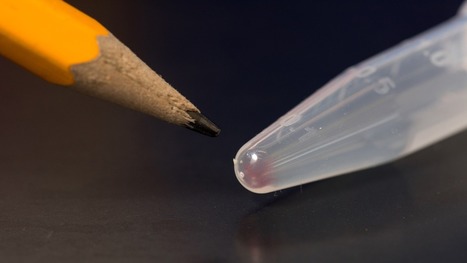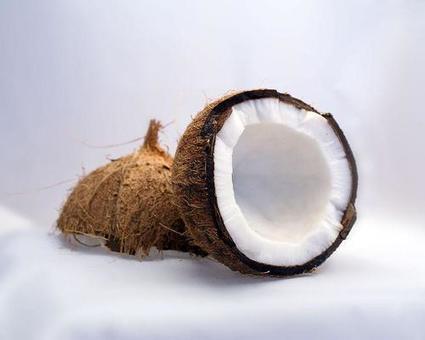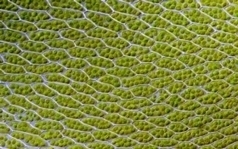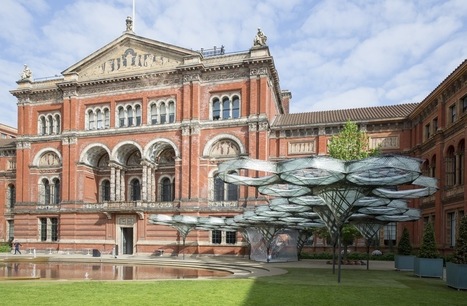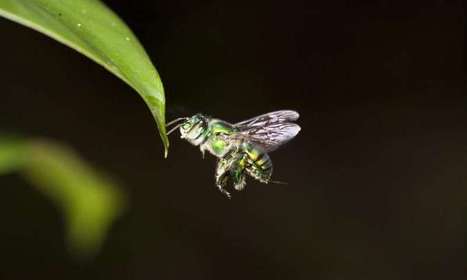 Your new post is loading...
 Your new post is loading...
The mudskipper is a fascinating animal, in that it's a fish that both swims in the water and crawls on the land. It's probably not unlike the prehistoric fishes that first ventured out of the ocean, hundreds of millions of years ago. Looking at it, you might think that its two pectoral fins do all the work when it's out of the water, while its tail just flaps around. By building a robotic version of the mudskipper, however, scientists have learned that its tail plays a crucial role while it's on the land – the finding could have implications for the design of walking robots.
"It looks like a test tube with dried salt at the bottom, but Microsoft says it could be the future of data storage. The company reported today that it had written roughly 200 megabytes of data, including War and Peace and 99 other literary classics, into DNA. Researchers have demonstrated that digital data can be stored in DNA before, but Microsoft says none have written so much of it into DNA at once. DNA is a good storage medium because data can be written into molecules more densely than the basic elements of conventional storage technologies can pack it in companies rely on today."
Plenty of birds fly vast distances on their migratory trips around planet Earth. But the most amazing of all might the frigate bird, which can stay aloft for two months straight without landing or resting. How the heck do they do that?
A team of biologists led by Henri Weimerskirch at the French National Center for Scientific Research just announced the results of a major new study on great frigates (Fregata minor), these fascinating seabirds native to the central Indian and Pacific Oceans. Using super-lightweight GPS trackers, the biologists followed four dozen birds from 2011 to 2015, some for up to two years continuously. What they found was astonishing. The birds could stay aloft for up to 56 days without landing, gliding for hundreds of miles per day with wing-flaps just every 6 minutes, and reaching altitude of more than 2.5 miles.
A biological material that has existed for millions of years may find new applications in modern electronics. A team of scientists from UC Santa Cruz, the University of Washington, and the Benaroya Research Institute at Virginia Mason discovered that shark “jelly” is the highest proton conductive biological substance ever found, according to GizMag. In plain English, that means the material is extremely good at detecting weak electrical signals from great distances away — something that scientists and engineers believe could be useful in future sensor design.
Scientists have discovered a previously unknown property of spider silk, and used it to create a remarkable new “hybrid” material. The new bio-inspired thread, which acts like both a solid and a liquid, could lead to a host of new materials and technologies.
Researchers at the University of California, Riverside and Purdue University have used the mantis shrimp as inspiration for a new 3D printed material. The crustacean’s club-like appendage, used to beat prey, consists of an unusual herringbone pattern, which the researchers synthetically replicated.
The mantis shrimp is a small, multi-coloured marine crustacean, with a number sporting fist-like appendage called a dactyl club. This particular variety of mantis shrimp is known as a smasher, as it crushes its prey with its club. Through the study of these creatures, researchers at University of California Riverside and Purdue University, USA, have taken steps toward developing ultra strong composite materials based on the unique herringbone structure within the dactyl club’s outer layer.
To make robots more cooperative and have them perform tasks in close proximity to humans, they must be softer and safer. A new actuator developed by a team led by George Whitesides, Ph.D. - who is a Core Faculty member at Harvard's Wyss Institute for Biologically Inspired Engineering [...] - generates movements similar to those of skeletal muscles using vacuum power to automate soft, rubber beams.
"Some business thinkers have argued that companies are like biological species and have tried to extract business lessons from biology, with uneven success. We stress that companies are identical to biological species in an important respect: Both are what’s known as complex adaptive systems. Therefore, the principles that confer robustness in these systems, whether natural or manmade, are directly applicable to business."
Combining the best features of a lobster and an African fish, engineers have created an artificial eye that can see in the dark. And their fishy false eyes could help search-and-rescue robots or surgical scopes make dim surroundings seem bright as day.
Comparable to some other animals on our planet, bats use other methods instead sight in order to navigate or hunt. They are able to “see” in the dark by sending out sound waves that bounce back to the bats’ ears from objects such as fruit on trees and flying insect prey. The echolocation or biosonar is currently a simpler way for robots to perceive shapes than pattern recognition programs and is much more applicable in areas without the needed light.
"Scientists have built a mathematical model to explain the secrets of the chameleon's extraordinary tongue. It took more than 20 equations to capture mathematically how the reptile's tongue unravels at very high speed to snare insects. The model explains the mechanics of the animal's tongue and the inherent energy build-up and rapid release. British researchers say the insights will be useful in biomimetics - copying from nature in engineering and design."
Looking for skis to maximize the fun as you hurtle down the slopes? The ideal ski can withstand high levels of pressure in turns yet also be easy to maneuver. These two features usually require two different types of skis: the rigid skis preferred by expert skiers or the flexible ones that intermediate skiers opt for. But a new type of ski offers a two-in-one solution thanks to a design based on turtle scales.
|
Kevin Kit Parker wants to build a human heart. His young daughter loves the New England Aquarium in Boston. In this Science report, father’s and daughter’s obsessions have combined in an unlikely creation: a nickel-sized artificial stingray whose swimming is guided by light and powered by rat heart muscle cells.
"Coconut palms can grow as high as 30m, and when the ripe fruits fall to the ground their walls must protect them from splitting open. To protect the internal seed, coconuts have a structure of three layers which allow them to withstand heavy impacts. The university’s Plant Biomechanics Group believes this specialised structure could be applied in architecture, and has been working with civil engineers and material scientists to develop this idea as part of a programme called Biological Design and Integrative Structures. [...] The group found that the ladder-like design of vessels in the coconut’s inner endocarp layer “dissipates energy via crack deflection," meaning newly-developed cracks created by an impact don't run directly through the hard shell, but are diverted and stop before the crack separates the fruit. "
The Asian green mussel (Perna viridis) anchors itself underwater by timed secretion of adhesive proteins from threadlike foot extensions, a team of researchers in Singapore finds1.
Lab experiments and computer simulations reveal that an especially long sticky protein acts as a primer — first catching the surface and repelling water molecules to make way for two proteins that form the final adhesive pad.
The discovery could lead to new submersible glues or improved paints to prevent biofouling on ship hulls and drilling platforms.
"Charles Darwin was the first to observe that Ivy exudes a liquid adhesive that helps it to cling to surfaces. Now researchers at Ohio State University have identified the protein that allows Ivy to stick. Nanospherical arabinogalactan proteins (AGPs) allow Ivy’s adhesive to enter nanoscale openings rather than just coating surfaces. Curing takes place due to calcium-driven electrostatic interactions among carboxyl groups of the AGPs and pectic acids. As water evaporates from the adhesive, chemical bonds are formed between adhesive and substrate. The researchers say that their discovery opens up the possibility of applying its findings to the development of adhesives for a wide range of applications ranging from medical adhesives to coatings and even cosmetics."
"A team of scientists at the Wyss Institute for Biologically Inspired Engineering at Harvard University and the Harvard John A. Paulson School of Engineering and Applied Sciences has evolved their microscale 3D printing technology to the fourth dimension, time. Inspired by natural structures like plants, which respond and change their form over time according to environmental stimuli, the team has unveiled 4D-printed hydrogel composite structures that change shape upon immersion in water."
"[...]It’s simple math. Like dinosaurs, organizations keep getting bigger, but they need huge bones to support the weight of all that complexity. The more weight, the more bones; the more bones, the more weight. It’s a catch-22. Management is the ponderous skeleton that keeps organizations from collapse. But as they grow, the costs of management rise, and the ability to adapt declines. When sudden change comes, there’s not much a company can do—it’s a sitting duck (or dinosaur) for the next cosmic collision. Hierarchies can only scale so much—we can’t grow bigger bones forever.[...]"
A tree's leaf, a blade of grass, a single algal cell: all make fuel from the simple combination of water, sunlight and carbon dioxide through the miracle of photosynthesis. Now scientists say they have replicated—and improved—that trick by combining chemistry and biology in a "bionic" leaf.
“An elytron is very delicate and super lightweight, because after all, the beetle still needs to fly,” says Achim Menges, an architect and professor at the University of Stuttgart. “At the same time it’s very robust and exceptionally high performance.”
It was these elytra, the fibrous structures in the forewing shells of flying beetles, that inspired the Elytra Filament Pavilion.
The Canadian company WhalePower has granted an exclusive, worldwide, manufacturing license to TEG, a German company specialized in efficient, green forms of energy generation, to use WhalePower’s Tubercle Technology to create retrofit blade kits for wind turbines. Tubercle Technology is inspired by the flippers of Humpback Whales and can be used to improve the efficiency of turbines, compressors, pumps and fans.
Bees control their flight using the speed of motion (optic flow) of the visual world around them. A study by Scientists at the University of Sheffield Department of Computer Science suggests how motion-direction detecting circuits could be wired together to also detect motion-speed, which is crucial for controlling bees’ flight.
“Honeybees are excellent navigators and explorers, using vision extensively in these tasks, despite having a brain of only one million neurons,” said Alex Cope, PhD., lead researcher on the paper. “Understanding how bees avoid walls, and what information they can use to navigate, moves us closer to the development of efficient algorithms for navigation and routing, which would greatly enhance the performance of autonomous flying robotics,” he added.
"After studying how insects navigate through dense vegetation, researchers at Lund University in Sweden have come up with a system that can be applied to flying robots. By adapting the system to drones, they can be made to adjust their speed to their surroundings and fly on their own- completely without human intervention and control. The breakthrough was made by vision researchers Emily Baird and Marie Dacke at the Department of Biology in Lund. Among other things, their research shows how bees that fly through dense forests assess light intensity to avoid other objects and find holes in the vegetation to enable them to navigate safely."
One ant species in the Sahara Desert is covered by a silvery sheen of body hair that acts as a wearable sun shield for the creatures, a new study finds. The silvery hairs completely reflect the light like mirrors, preventing the ants from absorbing too much heat. That may help to explain how the Saharan silver ants can stay cool when temperatures in the arid region reach a blistering 122 degrees Fahrenheit (50 degrees Celsisus).
|

 Your new post is loading...
Your new post is loading...
 Your new post is loading...
Your new post is loading...







